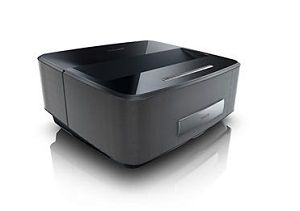‘Short-Throw’ LED TV Projector Nets CableLabs Kudos

“Screeneo,” a new, “short-throw” LED projector developed by Philips that can produce a flexible image up to 100 inches wide on a wall came away with the top honors at the Innovation Showcase at last week’s CableLabs Winter Conference in Atlanta.
Sagemcom, the France-based brand license partner for Philips projectors, said Screeneo came away with “Best new idea most likely to succeed” among cable engineers and execs at the event, beating out eight other entries.
Screeneo, introduced at the International CES in January, can produce a 50-inch image when placed only four inches from the wall, or a 100-inch image when the product is set back just 17 inches from the wall. In its presentation to CableLabs members, company execs noted that a traditional projector would need to be placed six to ten feet from the wall to create a similar-sized image.
The Screeneo connects to a cable box via the HDMI port, but Sagemcom is looking into future versions that will integrate a set-top box, execs said.
Offering features similar to those found in traditional “smart” TVs, the Wi-Fi- and DLNA-equipped Screeneo supports Android, meaning users can stream content from sources such as Netflix or Hulu Plus, has a built-in sound system, and can mirror tablet and smartphone content using its integrated Miracast functionality.
Screeneo is scheduled to go on sale in North American in May.
“With Screeneo, any wall in the home turns into a big smart screen with a great sound. We are excited leaders in the cable industry recognize Screeneo as a new product likely to find its way to their customer's households and extend their cable service consumption,” said Sagemcom EVP Nicolas Denis, in a statement.
Multichannel Newsletter
The smarter way to stay on top of the multichannel video marketplace. Sign up below.
Here’s a video of Sagemcom’s pitch at the invitation-only CableLabs event:
YOUi Labs of Ottawa beat out seven other companies to come away with similar honors at the Innovation Showcase held last August at the CableLabs Summer Conference in Keystone, Colo. It demonstrated uSwich, a framework that enables a gesture-based, “natural user interface” to operate on an array of set-tops, tablets, smartphones and other mobile devices.
